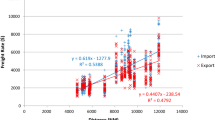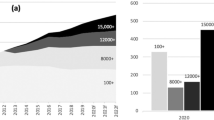Abstract
There is an unfolding phenomenon in the liner shipping sector that the cargo-carrying capacity of containerships continues to increase since the 1980s. While the main driver of the ship size increase is to achieve economies of scale by reducing unit costs, a plethora of studies in the maritime field have pointed out to the diseconomies of scale in port and along the supply chain. It is therefore of utmost importance to investigate the impact of the increase in the containership size on port operations. In this regard, this paper highlights the relationship between ship size and quay crane productivity by analysing a monthly dataset obtained from 5 container terminal operators in Busan New Port in the period 2013–2023. The impact of ship size on quay crane productivity is estimated in panel regressions controlling for berth and yard occupancy, container throughput. Consistent with the theoretical expectations in the earlier maritime literature, it is found that quay crane productivity is negatively affected by containership size and this relationship is robust also when yard congestion is considered as a controlling factor.

Similar content being viewed by others
Notes
Shipping Intelligence Network (https://sin.clarksons.net), Clarkson Research, accessed on 3rd October 2023.
Container Statistics of Busan Port, Busan Port Authority, each year.
The number of containers, out of the total number of containers onboard, unloaded at a certain port.
2022 Container Statistics of Busan Port, Busan Port Authority.
References
Alphaliner. 2023. Monthly Monitor, October 2023.
Baştuğ, S., H. Haralambides, S. Esmer, and E. Eminoğlu. 2022. Port competitiveness: Do container terminal operators and liner shipping companies see eye to eye? Marine Policy 135: 104866.
Bierwirth, C., and F. Meisel. 2010. A survey of berth allocation and quay crane scheduling problems in container terminals. European Journal of Operational Research 202 (3): 615–627.
Cullinane, K., and M. Khanna. 1999. Economies of scale in large container ships. Journal of Transport Economics and Policy 33 (2): 185–207.
Cullinane, K., and M. Khanna. 2000. Economies of scale in large containerships: Optimal size and geographical implications. Journal of Transport Geography 8 (3): 181–195.
Cullinane, K., and D.-W. Song. 2006. Estimating the relative efficiency of European container ports: A stochastic frontier analysis. Research in Transportation Economics 16: 85–115.
Cullinane, K., D.-W. Song, and R. Gray. 2002. A stochastic frontier model of the efficiency of major container terminals in Asia: Assessing the influence of administrative and ownership structures. Transportation Research Part a: Policy and Practice 36 (8): 743–762.
Cullinane, K., and T.-F. Wang. 2006. The efficiency of European container ports: A cross-sectional data envelopment analysis. International Journal of Logistics: Research and Applications 9 (1): 19–31.
Ducruet, C., H. Itoh, and O. Merk. 2014. Time efficiency at world container ports. International Transport Forum.
Gonzalez, M.M., and L. Trujillo. 2009. Efficiency measurement in the port industry: A survey of the empirical evidence. Journal of Transport Economics and Policy 43 (2): 157–192.
Haralambides, H.E. 2019. Gigantism in container shipping, ports and global logistics: A time-lapse into the future. Maritime Economics & Logistics 21 (1): 1–60.
Jansson, J.O., and D. Shneerson. 1982a. The optimal ship size. Journal of Transport Economics and Policy 16 (3): 217–238.
Jansson, J.O., and D. Shneerson. 1982b. Port Economics, vol. 8. Cambridge: MIT Press.
Jungen, H., P. Specht, J. Ovens, and B. Lemper. 2021. The rise of ultra large container vessels: Implications for seaport systems and environmental considerations. In Dynamics in Logistics: Twenty-Five Years of Interdisciplinary Logistics Research in Bremen, Germany, edited by Michael Freitag, Herbert Kotzab and Nicole Megow: Springer International Publishing Cham.
Lian, F., J. Jin, and Z. Yang. 2019. Optimal container ship size: A global cost minimization approach. Maritime Policy & Management 46 (7): 802–817.
Martin, J., S. Martin, and S. Pettit. 2015. Container ship size and the implications on port call workload. International Journal of Shipping and Transport Logistics 7 (5): 553–569.
McLellan, R. 1997. Bigger vessels: How big is too big? Maritime Policy and Management 24 (2): 193–211.
Meng, Q., J. Weng, and L. Suyi. 2017. Impact analysis of mega vessels on container terminal operations. Transportation Research Procedia 25: 187–204.
Merk, O., B. Busquet, and R. Aronietis. 2015. The Impact of Mega-ships. Case Specific Policy Analysis. International Transport Forum.
Musso, E., and A. Sciomachen. 2020. Impact of megaships on the performance of port container terminals. Maritime Economics & Logistics 22 (3): 432–445.
Pearson, R. 1988. Container ships and shipping. London: Fairplay Publications.
Petering, M.E.H. 2009. Effect of block width and storage yard layout on marine container terminal performance. Transportation Research Part e: Logistics and Transportation Review 45 (4): 591–610.
Rodrigue, J.-P. 2015. The disadvantages of scale in maritime shipping. https://www.porteconomics.eu/1065: Port Economics.
Rodrigues, F., and A. Agra. 2022. Berth allocation and quay crane assignment/scheduling problem under uncertainty: A survey. European Journal of Operational Research 303 (2): 501–524.
Salleh, N.H.M., N. Zulkifli, and J. Jeevan. 2021. The emergence of very large container vessel (VLCV) in maritime trade: Implications on the Malaysian seaport operations. WMU Journal of Maritime Affairs 20 (1): 41–61.
Sim, M.-S., Y.-S. Kim, and C.Y. Kim. 2023. Improvement of terminal efficiency in Busan New Port. International Journal of Transport Economics 50 (1–2): 89–113.
Slack, B., C. Comtois, B. Wiegmans, and P. Witte. 2018. Ships time in port. International Journal of Shipping and Transport Logistics 10 (1): 45–62.
Suárez-Alemán, A., L. Trujillo, and K.P. Cullinane. 2014. Time at ports in short sea shipping: When timing is crucial. Maritime Economics & Logistics 16 (4): 399–417.
Turner, H., R. Windle, and M. Dresner. 2004. North American containerport productivity: 1984–1997. Transportation Research Part e: Logistics and Transportation Review 40 (4): 339–356.
Van Hassel, E., H. Meersman, E. Van de Voorde, and T. Vanelslander. 2016. Impact of scale increase of container ships on the generalised chain cost. Maritime Policy & Management 43 (2): 192–208.
Yahalom, S., and C. Guan. 2018. Containership port time: The bay time factor. Maritime Economics & Logistics 20 (2): 211–227.
Acknowledgements
The authors would like to sincerely thank the reviewers, the editor and the Editor-in-Chief for providing valuable feedback. The paper has greatly benefited from critical comments and constructive suggestions made by them. All remaining errors are our own. This study originates as part of Byungkwon Jeong’s master’s degree dissertation at the Korea Maritime and Ocean University. The study has been further developed and revised after the completion of the dissertation. The work was supported by the 4th Maritime Port Logistics Training Project of the Ministry of Oceans and Fisheries (Republic of Korea).
Author information
Authors and Affiliations
Corresponding author
Additional information
Publisher's Note
Springer Nature remains neutral with regard to jurisdictional claims in published maps and institutional affiliations.
Rights and permissions
Springer Nature or its licensor (e.g. a society or other partner) holds exclusive rights to this article under a publishing agreement with the author(s) or other rightsholder(s); author self-archiving of the accepted manuscript version of this article is solely governed by the terms of such publishing agreement and applicable law.
About this article
Cite this article
Jeong, B., Kim, C.Y. Containership size and quay crane productivity: empirical evidence from Busan New Port. Marit Econ Logist (2024). https://doi.org/10.1057/s41278-024-00286-0
Accepted:
Published:
DOI: https://doi.org/10.1057/s41278-024-00286-0




